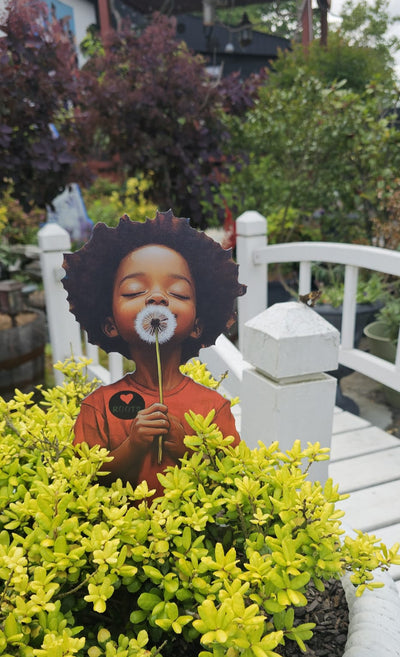Political Protest Simmers In Pieces Of BAIA’s Portfolio
Political protest simmers in pieces of BAIA’s Portfolio
By Angela Oliver

Hell breaks loose when the heat rises.
Kevin “WAK” Williams captures the sweltering summer of 2020 in his massive portrait, Date Night. It’s one of the centerpieces of Black Art in America’s current exhibition, Portfolio: Holdings and Recent Acquisitions.
In it, a young couple — masked by black bandanas and armed with a bullhorn — show the intimacy of fighting for their lives during a stretch of worldwide protests after Minneapolis police murdered George Floyd. The man in the portrait holds a downturned image of Floyd on a poster, signaling his sunset.
The man’s unapologetic middle finger to the systems of oppression recall the righteous rage of that summer, with Floyd’s death compounded by the state-sponsored murders of Breonna Taylor and Ahmaud Arbery just months earlier.
Even against a chaotic black and white background of paint splatter, everything about them is clear and calm.
“There are a lot of interesting elements in this piece,” said BAIA Foundation Director Faron Manuel. “It was an outlet for the artist to express what he was feeling in that moment. And not just his own sentiment, but the sentiment of so many people for too long.”
Date Night, along with several other pieces in this exhibit, embody the artists’ duty to reflect the times.
Beside the painting, Larry Walker’s Recessed Wall with Dream Catcher, Wall
Spirits and Other Secret Manifestations boasts his signature mixed-media collage style.
One could turn the corner in any city in America and face such a brick wall, covered in a mix of graffiti, movie posters, and stickers encouraging passersby to organize and resist. Alarming newspaper clippings and the terror of racists draped in white robes and hoods are quieted by more hopeful images like that of President Barack Obama. And by the color blue streaking down the recessed area of the wall.
A dreamcatcher hangs in the foreground. Its feathery existence seems out of place as it is surrounded by the jagged edges of the clippings and ripped posters.
“He’s not putting much of his own text or images into these pieces, but they’re collaged in a new way that creates a new meaning,” Manuel said.
The same style covers Walker’s ZAP (Simulated Inner City Telephone Pole), which is far less political in its imagery, but still places the viewer in an inner-city atmosphere.
Another familiar atmosphere leaps from the canvas of Khalif Thompson’s Baldwin, which places viewers in a room with the prolific and prophetic writer, James Baldwin. The painting is textured by collage elements, such as the strips of fabric that make up the books on a bookshelf, and parts of the tattered tile floor.

A caged bird sits on a table next to Baldwin, honoring his storied friendship with his fellow wordsmith Maya Angelou. Above it hangs a photo of modernist painter Beauford Delaney. The two enjoyed nearly 40 years of friendship — as queer men in the mid-20th century, their existence alone was a form of protest, fitting for this section of Portfolio — which was explored in a 2020 exhibit in Delaney’s hometown. And as history tells it, Delaney’s paintings became more expressive as their friendship grew. His appearance in Thompson’s painting is a nod to Delaney’s renowned portrait of Baldwin which also has a pale yellow background.
Like the lovers in Date Night, Baldwin is front-facing as are the other elements in the painting. Nothing is hidden or implied. Rather, these pieces loudly reflect the influence friends and environment can have on individuals.
Walker’s works are more subtle in presenting the ways the environment connects to its people. But this group of works does well in balancing the blaring symbols of protest and Black identity with more conspicuous arrangements that leave the heat of social consciousness to simmer rather than explode.






















